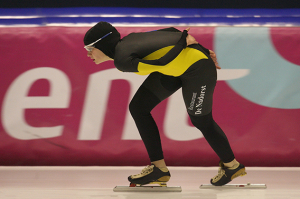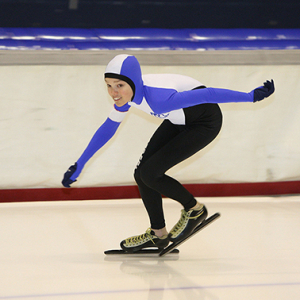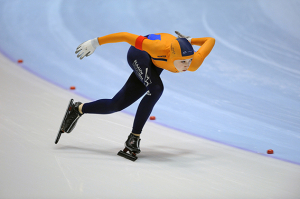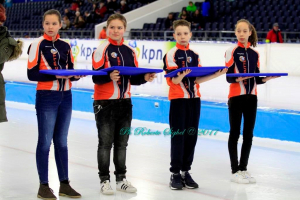Geschiedenis Vikingrace
For English please scroll down.
In 1986 tijdens de Wereldkampioenschappen langebaan in Inzell kregen Sippy Tigchelaar en Geertje Meinema contact met een trainer en de voorzitter van de schaatsclub uit Tønsberg. Zij nodigden STC Rutten uit om mee te doen aan de jeugdwedstrijd in Tønsberg voor kinderen van 10 t/m 15 jaar.
De toenmalige voorzitter, Jur Souwman, stemde enthousiast in met dit initiatief.
In 1987 ging er een groep jeugd met trainers en ouders naar Tønsberg, waaronder Annamarie Thomas, om deel te nemen aan deze wedstrijd.
In 1988 nam naast STC Rutten ook Zweedse jeugd deel aan de Viking Løpet in Tønsberg. In dat jaar is toen besloten om een drietal Viking wedstrijden op te zetten. In januari de Viking Løpet in Eskilstuna in Zweden, in februari de Viking Løpet in Tønsberg in Noorwegen en in maart in Thialf te Heerenveen. Iedereen wilde graag records rijden in de net overdekte schaatshal. Alle drie wedstrijden danken hun naam aan de enthousiaste grondlegger van de gelijknamige schaatsfabriek onder leiding Jaap Havekotte.
In 1989 vond de eerste Viking Race plaats op 9 en 10 maart. Uitgenodigd waren 36 Noorse en 36 Zweedse schaatsers/sters en 72 Friese rijders en rijdsters. De kinderen werden ondergebracht in gastgezinnen met als doel de onderlinge contacten te versterken.
De schaatsers reden beide dagen 2 afstanden, waarna een klassement werd opgemaakt. De prijzen werden uitgereikt tijdens een groot feest in Emmeloord.
Dit was het begin van van deze grote internationale wedstrijd voor aanstormend schaatstalent.
In 1992 werd de Viking Race met een aantal landen uitgebreid: Duitsland, Polen en Finland. Het aantal deelnemers kwam toen op 192. Sindsdien is het aantal landen verder uitgebreid en tegenwoordig wordt de startlijst gevuld met 288 deelnemers waarvan een groot aantal rijders de wereldtop bereikt.
Vanaf het begin stond deze wedstrijd op de ISU kalender. Meedoen aan deze klassieker, de Viking Race, is vaak de basis voor een internationale carrière.
History
In 1986 during the World Long Track Championships in Inzell, Sippy Tigchelaar and Geertje Meinema got in touch with a trainer and the chairman of the ice skating club from Tønsberg (Norway). They invited STC Rutten to participate in their youth competition in Maier Arena, outdoor ice-rink, inTønsberg.
The former chairman, Jur Souwman , was very enthusiastic about this initiative.
In 1987, a group of youth aged 11 to 15 years old with trainers and parents went to Tønsberg, including Annamarie Thomas, to participate in this competition.
In 1988, in addition to STC Rutten, Swedish youth also participated in the Viking Løpet in Tønsberg. In that year it was decided to set up three Viking competitions. In January the Viking Løpet in Eskilstuna (Sweden), in February the Viking Løpet in Tønsberg (Norway) and in March in Thialf in Heerenveen (The Netherlands). Everyone wanted to skate records in the newly covered skating hall Thialf. All three competitions owe their name to the enthusiastic founder of the skating factory of the same name, led by Jaap Havekotte (Viking).
In 1989, the first Viking Race took place on March 9th and 10th. Invited were 36 Norwegian, 36 Swedish and 72 Frisian speed skaters. The children were placed in host families with the aim of strengthening mutual contacts.
The skaters skated 2 distances on both days, after which a ranking was drawn up. The prizes were awarded during a big party in the city of Emmeloord.
This was the start of this major international competition for up-and-coming speedskating talent.
In 1992, the Viking Race was expanded with a number of countries: Germany, Poland and Finland. The number of participants increased to 192. Since then, the number of countries has expanded further and today the starting list is filled with 288 participants.
Several speed skaters who reached the international top have achieved places of honor during the Viking Race in the past.
From the beginning, this competition was on the ISU calendar. Participating in this classic, the Viking Race, is often the basis for an international career.











